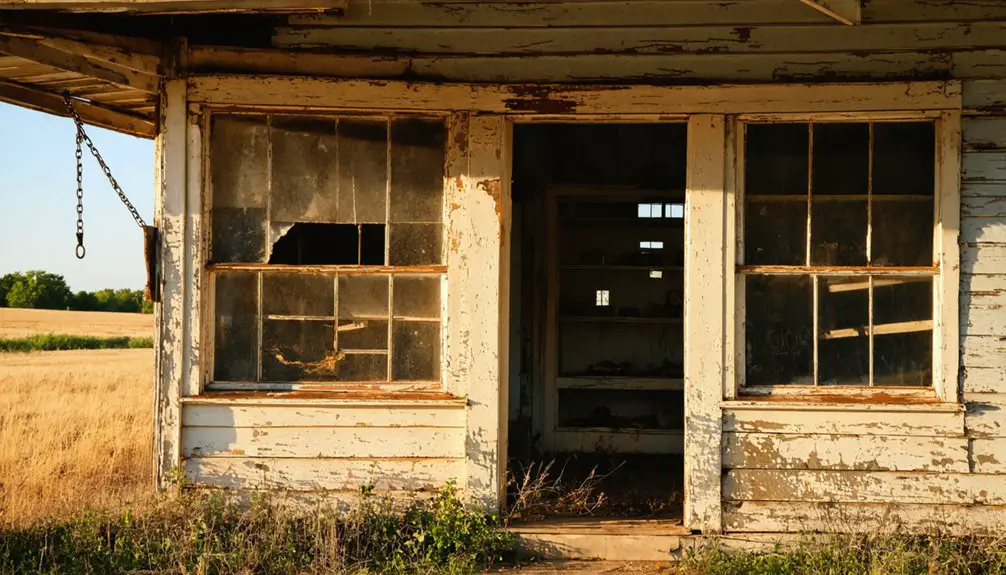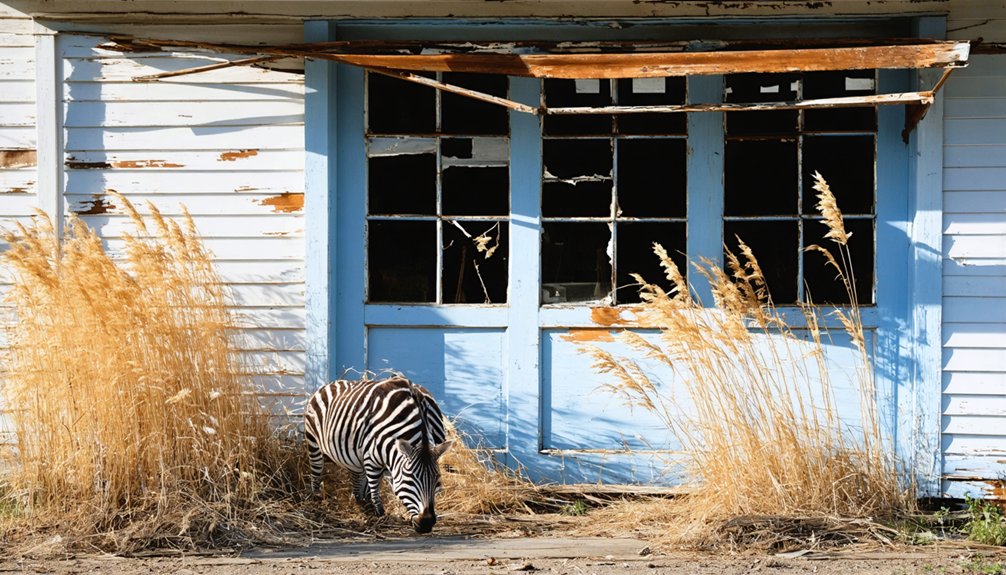You’ll find Fallis in Lincoln County, Oklahoma – a haunting ghost town that tells the story of Oklahoma’s railroad era. Originally established in 1892 as a mission settlement for Native American tribes, it flourished when two railroads arrived in the early 1900s, growing to 400 residents. The Great Depression, Dust Bowl, and a devastating 1960 fire led to its decline. Today, fewer than two dozen people live among the abandoned structures and whispered tales of its past.
Key Takeaways
- Fallis declined from a thriving railroad town of 400 residents in 1907 to a ghost town with only 6-21 residents today.
- A devastating fire in 1960 destroyed much of the town’s infrastructure, accelerating its transformation into a ghost town.
- Abandoned structures include a weathered schoolhouse, community center, hotels, and banks, attracting urban explorers.
- The town’s paranormal reputation stems from reported ghostly activities near the Iowa Indian graveyard and former tribal grounds.
- Geographic isolation and the diminishing importance of railroads contributed to Fallis’s abandonment during the Great Depression and Dust Bowl.
The Birth of a Mission Settlement
While many Oklahoma settlements emerged from railroad stops or land runs, Fallis began as “Mission” in 1892, serving Native American communities near an Iowa Indian village in Lincoln County. The Mission origins reflected a unique purpose – providing education and aid to the Sac and Fox, Iowa, and Kickapoo tribes under Quaker supervision.
You’ll find the settlement’s foundations were deliberately planned, with a tribal council house built in 1881 preceding the town’s establishment. The location, perched atop a wooded “long red hill,” provided strategic advantages for the early community.
Despite settlement challenges, the mission thrived under its first postmaster, John F. Murdock, until 1894 when William Henry Fallis took over development and renamed the town after himself. Under Murdock’s leadership, a day school opened in 1886 to serve the local Native American children. The town’s religious roots were typical of the era, as Quaker missionaries established the first Mission School in Lincoln County in 1872.
Native American Heritage and Tribal Significance
If you’re tracing the sacred legacy of Fallis’s Native American history, you’ll find the Iowa Indian village stood as a cultural cornerstone near Bear Creek in the 1880s.
The village featured a bark council house constructed in May 1881 where the tribe would gather for important meetings.
The Iowa people maintained deep cultural ties to their Red Earth origins beyond the great waters, shaping their traditions and way of life.
You can still picture the significant tribal councils held under the historic treaty tree, where Chief To-hee and other Iowa leaders made pivotal decisions affecting their people’s future.
This sacred ground became a decisive setting for the 1890 treaty signing that ultimately led to the opening of Iowa tribal lands for white settlement the following year.
Iowa Sacred Grounds
Throughout Iowa’s rich landscape, sacred Native American burial mounds and spiritual sites stand as enduring symbols to the region’s Indigenous heritage. You’ll find over 200 preserved mounds at Effigy Mounds National Monument alone, ranging from simple cones to intricate animal shapes.
These sacred sites, crafted by Woodland Indians over 200 years ago, mark burial grounds and places of deep cultural significance. The area contains remnants of an ancient stagecoach road that once connected Osceola to Indianola. Most of these significant locations are found near natural waterways that provided strategic resources for Native settlements.
Today, 26 tribes maintain spiritual connections to these grounds, even though they no longer reside in Iowa. The sacred preservation of these sites involves careful collaboration between conservation groups and tribal nations, ensuring respectful management while balancing public access.
These mounds embody the Indigenous worldview of interconnectedness between people, land, and nature, serving as essential links to ancestral practices and ceremonies.
Tribal Council Legacy
Deep within Lincoln County’s history, the Iowa tribe’s legacy near Fallis centers on its tribal council’s essential role in shaping Native American relations with the U.S. government.
You’ll find evidence of their tribal governance in the historic May 27, 1890 treaty, signed beneath an old tree near the Iowa village. Chief To-hee led significant treaty negotiations that would ultimately transform the landscape.
The council’s influence extended beyond treaty discussions, affecting daily life in the Iowa village that was established around 1880.
While you can trace the impact of their decisions through the subsequent opening of surplus lands in 1891, their commitment to preserving traditions remained strong.
The council maintained cultural practices like ceremonial gatherings and horse racing, even as mission schools and government policies pushed for assimilation.
The area, which was originally known as Mission before 1894, reflected the strong presence of Native American educational institutions in the region.
Railroad Era Prosperity and Growth
Fallis transformed into a significant railroad hub when the Katy Railroad built its line through the town in 1902, followed by the Fort Smith and Western Railway’s crossing in 1903.
You’ll find that these rail connections immediately boosted Fallis’s prominence as an agricultural shipping center, particularly for cotton, with two busy cotton gins operating in the community. The town sat near the vital Chisholm Trail, which had established the region as an important route for cattle drives.
The town’s population swelled to nearly 400 residents by 1907 statehood, as the convergence of rail lines attracted businesses and supported a thriving local economy built on agricultural exports, coal shipments, and modest oil-related freight. Unfortunately, like many rail towns of the era, Fallis’s prosperity would be challenged when the Fort Smith and Western entered bankruptcy in 1915.
Railroad Hub Development
At the dawn of the twentieth century, two major railroads transformed the small Oklahoma town of Fallis into a bustling transportation hub.
When the Missouri, Kansas and Texas Railway (Katy) and Fort Smith and Western Railway (FS&W) crossed paths in Fallis, you’d find a town pulsing with commerce at these strategic railroad intersections.
Agricultural transport flourished as cotton, livestock, and prairie goods moved through this essential shipping point.
- The Katy built lines to Oklahoma City in 1902 and Guthrie in 1903
- FS&W expanded westward through Fallis, connecting coal fields to larger markets
- Two cotton gins operated to process local crops for rail shipment
- The town’s population swelled to nearly 400 by statehood, driven by rail commerce
Economic Boom Years
During the first decade of the 1900s, you’d find a thriving economy in this small Lincoln County town, where three major industries converged to create unprecedented prosperity.
You could witness economic fluctuations as Fallis balanced its resource management between agriculture, coal, and oil development. The town’s 350-400 residents benefited from two cotton gins processing the area’s principal crop, while the Fort Smith and Western Railway transported coal from the rich Ouachita Mountain deposits. Similar to the Missouri, Kansas and Texas railway’s successful operations in other regions, the local railroad proved essential for the town’s development.
When the county’s first oil well was drilled near Fallis in 1904, it added another layer of opportunity to the mix. Despite disappointing coal shipping revenues, the combination of cotton farming, modest oil production, and railroad activity sustained a vibrant commercial center.
The town’s strategic position as a shipping hub for these resources defined its boom years.
Daily Life in Early Fallis
Life in early Fallis centered around the unique cultural exchange between settlers and the neighboring Iowa Indian village, which had established itself on the western edge of the Iowa Reservation around 1880.
You’d find a vibrant mix of traditions where community gatherings brought both cultures together, particularly at the council house built in 1881.
- Native celebrations and horse racing drew spectators from both communities, creating shared recreational experiences.
- Trading posts and general stores served as meeting points where settlers and Iowa tribe members conducted daily business.
- The council house became a central hub for tribal governance and social events.
- A network of trails connected Fallis to other settlements, including the Sac and Fox agency, making it easy for you to travel and trade between communities.
The Slow Decline of a Thriving Town

While Fallis once thrived as a bustling whistle-stop with multiple railroad lines supporting its hotels, banks, and lumber yards, the town’s fortunes began to shift dramatically in the 1930s.
The combined impact of the Great Depression, Dust Bowl, and declining railroad importance created a perfect storm of economic instability that you can still see today.
Three devastating forces – economic collapse, environmental disaster, and fading railroad relevance – dealt Fallis a blow from which it never recovered.
Despite the community’s resilience, a devastating fire in 1960 destroyed much of the town’s infrastructure, leaving wounds that never fully healed.
The population plummeted from 400 in its heyday to just 105 by 1950, and today fewer than two dozen people call Fallis home.
Geographic isolation and the inability to adapt to highway-based commerce sealed the town’s fate, though a small but determined population remains.
Legends and Local Stories
The ghostly mystique of Fallis extends far beyond its abandoned buildings and quiet streets.
You’ll discover a rich tapestry of supernatural stories tied to its Native American heritage, railroad era, and outlaw connections. The town’s most compelling legends center around the Iowa Indian graveyard, where visitors report ghostly encounters near Chief Tohee’s burial site.
- Eerie sounds pierce the darkness on quiet nights, echoing the spirits of Iowa Indians who once called this land home.
- Mysterious flickering lights, resembling ancient campfires, appear after sunset near former tribal grounds.
- The old railroad whistle-stop harbors tales of travelers, outlaws, and unexplained phenomena.
- The sacred burial grounds near town serve as a focal point for paranormal activity, where ancestral spirits are said to protect their eternal resting place.
Exploring the Ghost Town Today

Nestled atop a long red hill in Oklahoma, modern-day Fallis stands as a haunting tribute to its early 1900s railroad glory.
You’ll find abandoned structures scattered throughout the 0.34-square-mile town, including a weathered schoolhouse and community center frozen in time, with original files and yearbooks still intact.
For urban exploration enthusiasts, the town offers a raw glimpse into history through its decaying hotels, banks, and lumber yards.
While traversing the site, you’ll need to watch for broken glass and unstable flooring in the deteriorating buildings.
You might encounter some of the town’s few remaining residents – official counts vary from 6 to 21 people – or temporary occupants who’ve left behind mattresses and personal items in vacant structures.
Frequently Asked Questions
Are There Any Remaining Original Buildings From the 1890S Still Standing?
You won’t find original 1890s historical architecture in Fallis today, as most buildings were destroyed by a devastating 1960 fire, and minimal preservation efforts have maintained structures from that founding era.
What Happened to the Residents Who Left During the Town’s Decline?
Moving masses migrated to nearby towns like Wellston and urban centers in Lincoln County. Historical accounts show you’d find former residents scattered across Oklahoma, following economic opportunities and railroad job declines.
Is Permission Required to Visit and Explore the Ghost Town?
You’ll need to check property ownership and obtain permission, as parts may be private land. Follow visitation guidelines by staying on public roads unless you’ve secured landowner approval for exploration etiquette.
Have Any Archaeological Excavations Been Conducted at the Former Mission Site?
Like searching for hidden treasure in an empty chest, you won’t find documented archaeological excavations or findings at the mission site. There’s no evidence of formal digs or research being conducted.
Does Anyone Maintain Records of Births and Deaths From Early Fallis?
You’ll need to check Lincoln County offices and Oklahoma Historical Society for birth records and death records, though early Fallis documentation is fragmented across tribal archives and local historical societies.
References
- http://genealogytrails.com/oka/lincoln/townoffallis.html
- https://photos.legendsofamerica.com/fallisoklahoma-davidfisk
- https://en.wikipedia.org/wiki/Fallis
- https://www.youtube.com/watch?v=i6h5huyY4q0
- https://kids.kiddle.co/Fallis
- https://www.okgenweb.net/~oklincol/briefhistory.html
- https://victorythegame.com/inGame/uhn8jz/c95f40-fallis
- https://ioway.nativeweb.org/iowaylibrary/oldvillage.htm
- http://www.okterritory.org/history.html
- https://freepages.rootsweb.com/~sfollis/genealogy/states/oklahoma/fallisok.html



